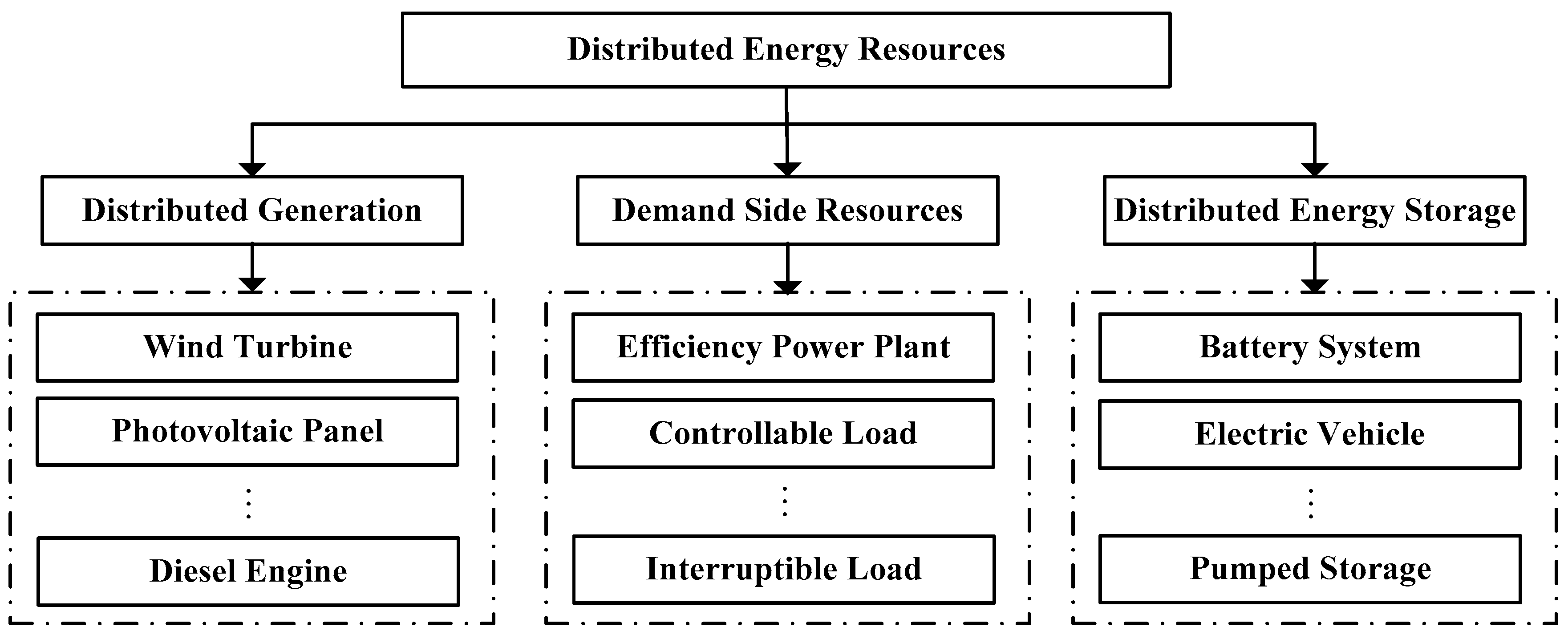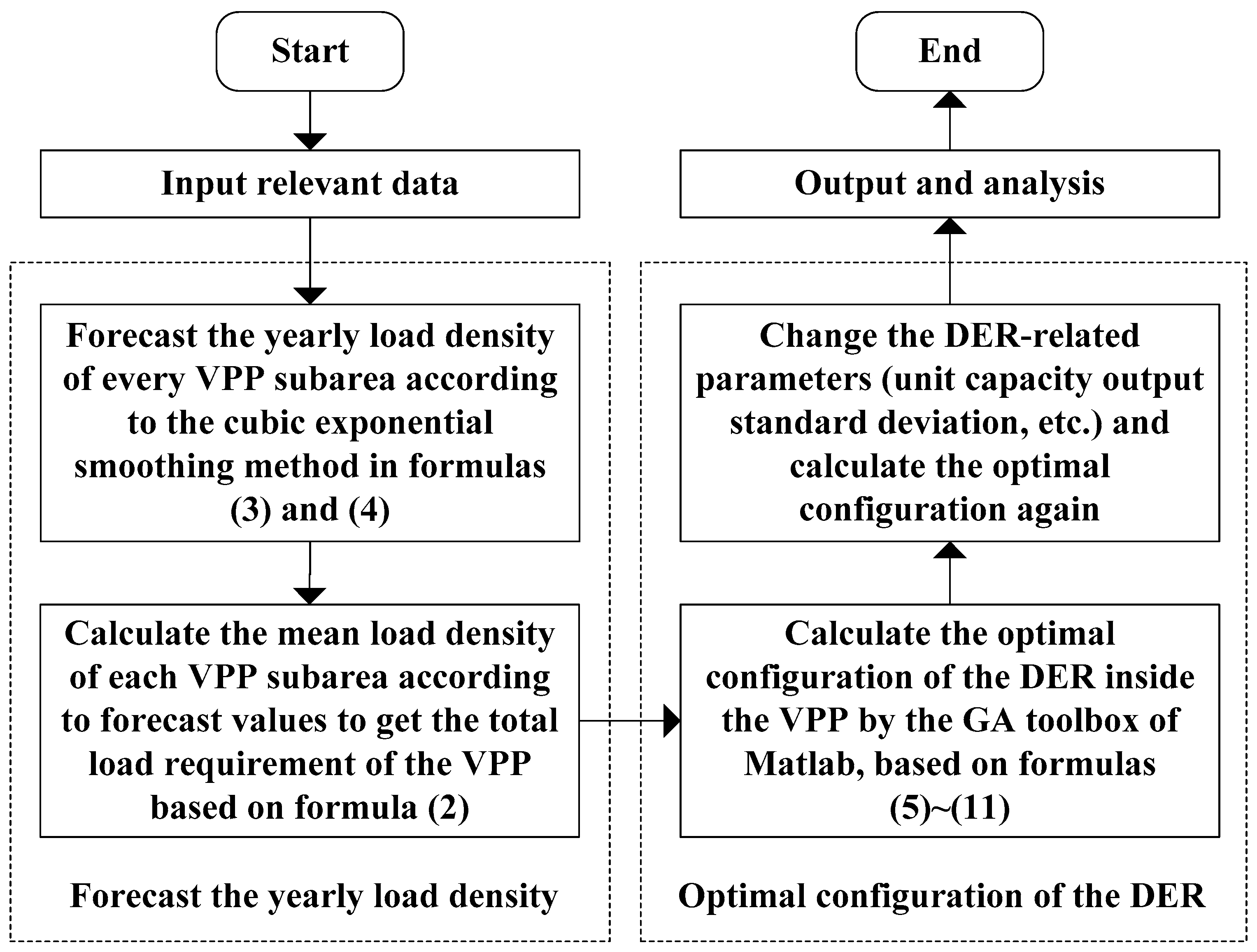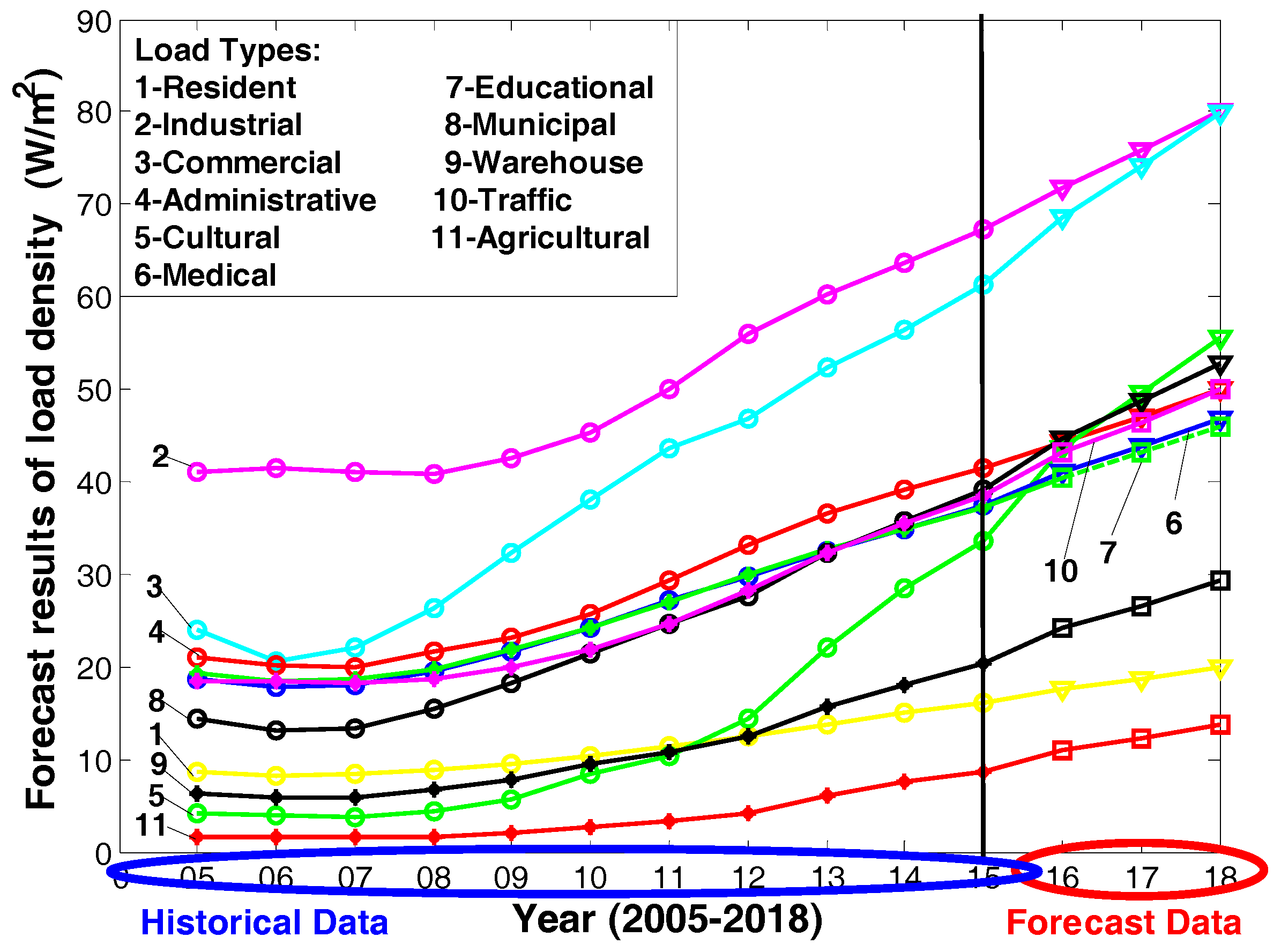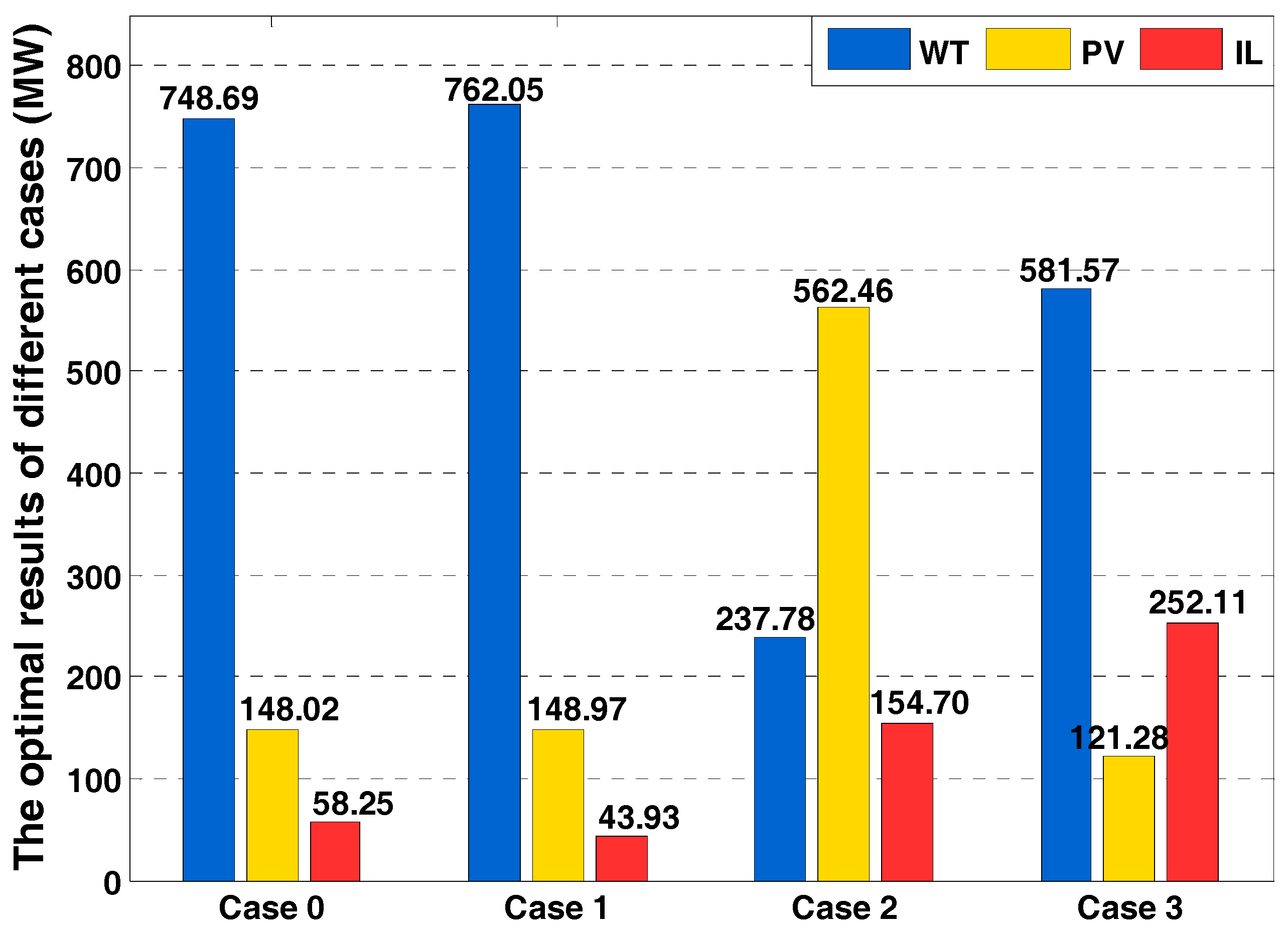The Optimal Configuration Scheme of the Virtual Power Plant Considering Benefits and Risks of Investors
Abstract
:1. Introduction
2. The Components of DERs
3. The Optimal Configuration Scheme of the VPP
3.1. The Division of the Service Regions of the VPP
3.2. The Forecast of Yearly Load Density per Hour
3.3. The Optimal Configuration of the VPP Based on the Portfolio Theory
4. Case Analysis
4.1. The Solving Procedure
4.2. Parameters Setting of the GA
- (1)
- Population: population type (double vector), population size (50), creation function (constraint dependent), initial population (default), initial scores (default), initial range ([−10, 10]).
- (2)
- Fitness scaling: scaling function (rank).
- (3)
- Selection: selection function (stochastic uniform).
- (4)
- Reproduction: elite count (0.05 × population size), crossover fraction (0.8).
- (5)
- Mutation: mutation function (constraint dependent).
- (6)
- Crossover: crossover function (constraint dependent).
- (7)
- Migration: direction (forward), fraction (0.2), interval (20).
- (8)
- Constraint parameters: initial penalty (10), penalty factor (100).
- (9)
- Stopping criteria: generations (100 × number of variables), time limit (default: +∞), fitness limit (default: −∞), stall generations (50), stall time limit (default: +∞), stall test (average change), function tolerance (10−6), constraint tolerance (10−6).
4.3. The Forecast of Yearly Load Density of Each Service Region of the VPP
4.4. The Optimal Configuration of DER Capacities inside the VPP
5. Conclusions
Acknowledgments
Author Contributions
Conflicts of Interest
Abbreviations
| DERs | Distributed energy resources |
| VPP | Virtual power plant |
| GA | Genetic algorithm |
| WT | Wind turbine |
| PV | Photovoltaic unit |
| IL | Interruptible load |
References
- Kazmi, S.A.A.; Shahzad, M.K.; Shin, D.R. Multi-objective planning techniques in distribution networks: A composite review. Energies 2017, 10, 208. [Google Scholar] [CrossRef]
- Dabbagh, S.R.; Sheikh-El-Eslami, M.K. Risk-based profit allocation to DERs integrated with a virtual power plant using cooperative Game theory. Electr. Power Syst. Res. 2015, 121, 368–378. [Google Scholar] [CrossRef]
- Baek, J.; Choi, W.; Chae, S. Distributed control strategy for autonomous operation of hybrid AC/DC microgrid. Energies 2017, 10, 373. [Google Scholar] [CrossRef]
- Cao, C.; Xie, J.; Yue, D.; Huang, C.; Wang, J.; Xu, S.; Chen, X. Distributed economic dispatch of virtual power plant under a non-ideal communication network. Energies 2017, 10, 235. [Google Scholar] [CrossRef]
- Nosratabadi, S.M.; Hooshmand, R.A.; Gholipour, E. Stochastic profit-based scheduling of industrial virtual power plant using the best demand response strategy. Appl. Energy 2016, 164, 590–606. [Google Scholar] [CrossRef]
- Gong, J.; Xie, D.; Jiang, C.; Zhang, Y. Multiple objective compromised method for power management in virtual power plants. Energies 2011, 4, 700–716. [Google Scholar] [CrossRef]
- Kardakos, E.G.; Simoglou, C.K.; Bakirtzis, A.G. Optimal offering strategy of a virtual power plant: A stochastic bi-level approach. IEEE Trans. Smart Grid 2016, 7, 794–806. [Google Scholar] [CrossRef]
- Gao, Y.; Cheng, H.; Zhu, J.; Liang, H.; Li, P. The optimal dispatch of a power system containing virtual power plants under fog and haze weather. Sustainability 2016, 8, 71. [Google Scholar] [CrossRef]
- Bliek, F.W.; van den Noort, A.; Roossien, B.; Kamphuis, R.; de Wit, J.; van den Velde, J.; Eijgelaar, M. The role of natural gas in smart grids. J. Nat. Gas Sci. Eng. 2011, 3, 608–616. [Google Scholar] [CrossRef]
- Wille-Haussmann, B.; Erge, T.; Wittwer, C. Decentralised optimisation of cogeneration in virtual power plants. Sol. Energy 2010, 84, 604–611. [Google Scholar] [CrossRef]
- Barszcz, T.; Czop, P. Presentation of a virtual power plant environment and its application with combined first-principle and data-driven models intended for the diagnostics of a power plant-Part 2. Simulation 2012, 88, 167–179. [Google Scholar] [CrossRef]
- Binding, C.; Gantenbein, D.; Jansen, B.; Sundstrom, O.; Andersen, P.B.; Marra, F.; Poulsen, B.; Traholt, C. Electric vehicle fleet integration in the Danish EDISON project–a virtual power plant on the island of Bornholm. In Proceedings of the 2010 IEEE Power and Energy Society General Meeting, Providence, RI, USA, 25–29 July 2010; IEEE: Piscataway, NJ, USA, 2010; pp. 1–8. [Google Scholar]
- Daud, S.; Kadir, A.F.A.; Gan, C.K.; Mohamed, A.; Khatib, T. A comparison of heuristic optimization techniques for optimal placement and sizing of photovoltaic based distributed generation in a distribution system. Sol. Energy 2016, 140, 219–226. [Google Scholar] [CrossRef]
- Esmaili, M.; Firozjaee, E.C.; Shayanfar, H.A. Optimal placement of distributed generations considering voltage stability and power losses with observing voltage-related constraints. Appl. Energy 2014, 113, 1252–1260. [Google Scholar] [CrossRef]
- Ali, E.S.; Elazim, S.M.A.; Abdelaziz, A.Y. Ant Lion Optimization Algorithm for optimal location and sizing of renewable distributed generations. Renew. Energy 2017, 101, 1311–1324. [Google Scholar] [CrossRef]
- Shahzad, M.; Ahmad, I.; Gawlik, W.; Palensky, P. Load concentration factor based analytical method for optimal placement of multiple distribution generators for loss minimization and voltage profile improvement. Energies 2016, 9, 287. [Google Scholar] [CrossRef]
- Mahesh, K.; Nallagownden, P.; Elamvazuthi, I. Advanced Pareto front non-dominated sorting multi-objective particle swarm optimization for optimal placement and sizing of distributed generation. Energies 2016, 9, 982. [Google Scholar] [CrossRef]
- Fan, S.; Ai, Q. Day-ahead scheduling strategy of virtual power plant under uncertainties. In Proceedings of the 2015 IEEE PES Asia-Pacific Power and Energy Engineering Conference (APPEEC), Brisbane, Australia, 15–18 November 2015; IEEE: Piscataway, NJ, USA, 2015; pp. 1–5. [Google Scholar]
- Fan, S.; Ai, Q.; Piao, L. Fuzzy day-ahead scheduling of virtual power plant with optimal confidence level. IET Gener. Trans. Distrib. 2016, 10, 205–212. [Google Scholar] [CrossRef]
- Nguyen, D.T.; Nguyen, H.T.; Le, L.B. Coordinated dispatch of renewable energy sources and HVAC load using stochastic programming. In Proceedings of the 2014 IEEE International Conference on Smart Grid Communications (SmartGridComm), Venice, Italy, 3–6 November 2014; IEEE: Piscataway, NJ, USA, 2014; pp. 139–144. [Google Scholar]
- Liang, Z.; Guo, Y. Robust optimization based bidding strategy for virtual power plants in electricity markets. In Proceedings of the Power and Energy Society General Meeting (PESGM), Boston, MA, USA, 17–21 July 2016; IEEE: Piscataway, NJ, USA, 2016; pp. 1–5. [Google Scholar]
- Dolara, A.; Grimaccia, F.; Magistrati, G.; Marchegiani, G. Optimization models for islanded micro-grids: A comparative analysis between linear programming and mixed integer programming. Energies 2017, 10, 241. [Google Scholar] [CrossRef]
- Pudjianto, D.; Ramsay, C.; Strbac, G. Microgrids and virtual power plants: Concepts to support the integration of distributed energy resources. Proc. Inst. Mech. Eng. Part A J. Power Energy 2008, 222, 731–741. [Google Scholar] [CrossRef]
- Asmus, P. Microgrids, virtual power plants and our distributed energy future. Electr. J. 2010, 23, 72–82. [Google Scholar] [CrossRef]
- Palizban, O.; Kauhaniemi, K.; Guerrero, J.M. Microgrids in active network management—Part I: Hierarchical control, energy storage, virtual power plants, and market participation. Renew. Sustain. Energy Rev. 2014, 36, 428–439. [Google Scholar] [CrossRef]
- Jiang, Q.; Xue, M.; Geng, G. Energy management of microgrid in grid-connected and stand-alone modes. IEEE Trans. Power Syst. 2013, 28, 3380–3389. [Google Scholar] [CrossRef]
- Wang, S. Design and operation of micro-grid based on distributed generation. Electr. Power Autom. Equip. 2011, 31, 120–123. [Google Scholar]
- Yang, W.; Li, C.; Luan, J.; Zhang, B. Microgrid capacity allocation scheme based on load analysis and optimization control. Electr. Meas. Instrum. 2014, 51, 13–16. [Google Scholar]
- Morais, H.; Kadar, P.; Faria, P.; Vale, Z.A.; Khodr, H.M. Optimal scheduling of a renewable micro-grid in an isolated load area using mixed-integer linear programming. Renew. Energy 2010, 35, 151–156. [Google Scholar] [CrossRef]
- Rezvani, A.; Gandomkar, M.; Izadbakhsh, M.; Ahmadi, A. Environmental/economic scheduling of a micro-grid with renewable energy resources. J. Clean. Prod. 2015, 87, 216–226. [Google Scholar] [CrossRef]
- Chen, J.; Fu, C.; Chen, R.; Liu, Y. The stability of islanded-operation microgrid with various types of distributed energy sources. South. Power Syst. Technol. 2013, 7, 71–74. [Google Scholar] [CrossRef]
- Brown, R.G. Smoothing, Forecasting and Prediction of Discrete Time Series; Courier Corporation: North Chelmsford, MA, USA, 2004. [Google Scholar]
- Huang, X.; Li, J.; Yang, L.; Jiang, J.; Feng, C. Investment portfolio based multi energy capacity allocation of virtual power plant. Autom. Electr. Power Syst. 2015, 39, 75–81. [Google Scholar]





| Serial Number | Service Region | Acreage/(km2) | Mean Value of Load Density/(w/m2) | Load Requirement/(MW) |
|---|---|---|---|---|
| 1 | Residential | 22.8900 | 18.6700 | 427.3563 |
| 2 | Industrial | 5.1400 | 75.9000 | 390.1260 |
| 3 | Commercial | 4.9900 | 74.2000 | 370.2580 |
| 4 | Administrative | 2.0200 | 47.1100 | 95.1622 |
| 5 | Cultural | 1.6400 | 49.5900 | 81.3276 |
| 6 | Medical | 0.8100 | 43.8600 | 35.5266 |
| 7 | Educational | 3.2100 | 43.1200 | 138.4152 |
| 8 | Municipal | 7.3700 | 48.7700 | 359.4349 |
| 9 | Warehouse | 0.5400 | 26.6800 | 14.4072 |
| 10 | Traffic | 1.0900 | 46.4800 | 50.6632 |
| 11 | Agricultural | 2.0500 | 12.3000 | 25.2150 |
| Sum | — | 51.7500 | — | 1987.8922 |
| Unit Capacity | WT | PV | IL | Thermal Power Unit (Miniature Gas Turbine) |
|---|---|---|---|---|
| Electrovalence/(yuan/MW) | 580 | 1660 | 540 | 420 |
| Cost/(yuan/MW) | 153 | 242 | 178 | 255 |
| Expected output | 0.3600 | 0.1900 | 0.3200 | 0.5800 |
| Standard deviation of output | 0.0800 | 0.0960 | 0.0650 | — |
| Case | Optimal Configuration Results | WT | PV | IL |
|---|---|---|---|---|
| 0 | Configuration ratios | 37.66% | 7.45% | 2.93% |
| Expectation and variance of ϕv The investor utility | E(ϕv) = 0.3312, σv2 = 0.0652 U = 0.1208 | |||
| 1 | Configuration ratios | 38.33% | 7.49% | 2.21% |
| Expectation and variance of ϕv The investor utility | E(ϕv) = 0.3370, σv2 = 0.0673 U = 0.1208 | |||
| 2 | Configuration ratios | 11.96% | 28.29% | 7.78% |
| Expectation and variance of ϕv The investor utility | E(ϕv) = 0.2647, σv2 = 0.1528 U = 0.0032 | |||
| 3 | Configuration ratios | 29.26% | 6.10% | 12.68% |
| Expectation and variance of ϕv The investor utility | E(ϕv) = 0.2529, σv2 = 0.0426 U = 0.1140 | |||
© 2017 by the authors. Licensee MDPI, Basel, Switzerland. This article is an open access article distributed under the terms and conditions of the Creative Commons Attribution (CC BY) license (http://creativecommons.org/licenses/by/4.0/).
Share and Cite
Wang, J.; Yang, W.; Cheng, H.; Huang, L.; Gao, Y. The Optimal Configuration Scheme of the Virtual Power Plant Considering Benefits and Risks of Investors. Energies 2017, 10, 968. https://doi.org/10.3390/en10070968
Wang J, Yang W, Cheng H, Huang L, Gao Y. The Optimal Configuration Scheme of the Virtual Power Plant Considering Benefits and Risks of Investors. Energies. 2017; 10(7):968. https://doi.org/10.3390/en10070968
Chicago/Turabian StyleWang, Jingmin, Wenhai Yang, Huaxin Cheng, Lingyu Huang, and Yajing Gao. 2017. "The Optimal Configuration Scheme of the Virtual Power Plant Considering Benefits and Risks of Investors" Energies 10, no. 7: 968. https://doi.org/10.3390/en10070968





